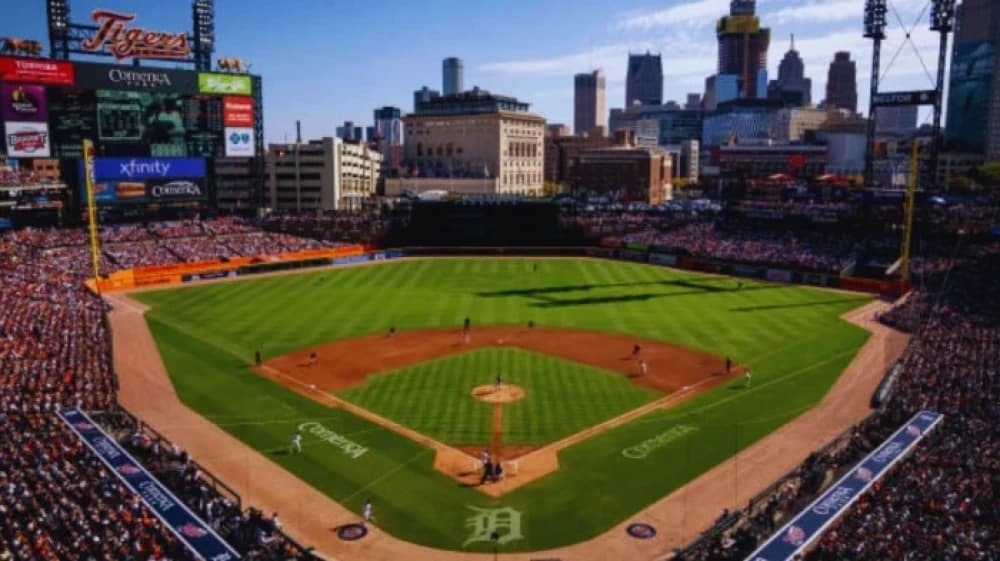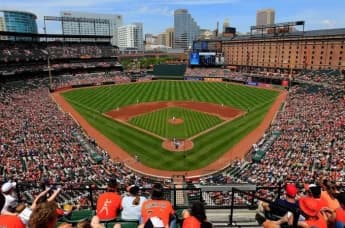A modern marvel blending tradition and innovation, Comerica Park stands as a symbol of Detroit’s resilience, offering world-class baseball, unforgettable fan experiences, and a vibrant hub for the city’s revival.
Introduction
Nestled in the heart of downtown Detroit, Comerica Park is more than just a baseball stadium—it’s a cultural landmark and a testament to the city’s enduring love for America’s favorite pastime. Since its opening in 2000, Comerica Park has served as the home of the Detroit Tigers, replacing the historic Tiger Stadium while honoring its legacy. With its unique blend of modern amenities, family-friendly attractions, and a deep connection to Detroit’s rich baseball history, Comerica Park has become a cornerstone of the city’s revitalization and a beloved destination for fans of all ages.
A New Era for Detroit Baseball
The decision to build Comerica Park marked a pivotal moment in Detroit’s sports history. By the mid-1990s, Tiger Stadium, though steeped in nostalgia, had become outdated, lacking the modern facilities needed to compete in the evolving world of professional sports. Under the leadership of Tigers owner Mike Ilitch, plans were set in motion to create a state-of-the-art ballpark that would not only enhance the fan experience but also contribute to the economic and cultural revival of downtown Detroit.
Construction began in 1997, with the stadium strategically located along Woodward Avenue, near the future site of Ford Field. Designed by the renowned architectural firm HOK Sport (now Populous), Comerica Park was envisioned as a modern facility that paid homage to the classic ballparks of the early 20th century. Its red brick exterior, asymmetrical field dimensions, and open design offering panoramic views of the Detroit skyline seamlessly integrated the stadium into the city’s urban fabric.
On April 11, 2000, Comerica Park officially opened its doors, welcoming fans to a new era of Tigers baseball. The inaugural game against the Seattle Mariners was a celebration of Detroit’s baseball heritage, featuring appearances by Tigers legends and a sense of optimism for the future. The stadium’s debut was met with widespread acclaim, as fans marveled at its modern amenities, family-friendly attractions, and breathtaking views of the city.
Architectural Brilliance and Fan-Centric Design
Comerica Park’s design is a masterful blend of tradition and innovation. The stadium’s exterior, with its red brick and limestone accents, evokes the charm of classic ballparks like Wrigley Field and Fenway Park, while its open concourses and modern amenities cater to the needs of contemporary fans.
One of the most striking features of Comerica Park is its grand entrance, guarded by towering tiger statues that symbolize the team’s fierce spirit. These sculptures, designed by artist Michael Keropian, are a testament to the stadium’s commitment to creating a memorable first impression. Inside, the park’s wide concourses and interactive exhibits, such as the Walk of Fame and bronze statues of Tigers legends, celebrate the team’s storied history and connect fans to its rich legacy.
The seating layout at Comerica Park was designed with fan comfort in mind. With a capacity of approximately 41,000, the stadium offers a variety of seating options, from traditional grandstand seats to luxurious suites and party decks. The steep incline of the seating tiers ensures clear sightlines, while the open design provides stunning views of the Detroit skyline, creating a picturesque backdrop for every game.
Family-Friendly Attractions and Culinary Delights
Comerica Park is renowned for its family-friendly attractions, making it a destination for fans of all ages. The Big Cat Court features a hand-painted tiger-themed carousel and a Ferris wheel with baseball-shaped gondolas, offering entertainment for younger fans and adding to the park’s lively atmosphere. Interactive exhibits, such as a pitching cage and batting challenge, allow fans to test their skills and engage with the game in new ways.
The culinary offerings at Comerica Park are equally impressive, showcasing Detroit’s rich food culture alongside classic ballpark fare. Fans can enjoy local favorites like Coney Island dogs and Detroit-style pizza, as well as innovative options like gourmet burgers and specialty nachos. The diverse selection ensures that every fan can find something to savor, enhancing the overall game-day experience.
A Stage for Historic Moments
Since its opening, Comerica Park has been the site of numerous historic moments that have left an indelible mark on baseball history. In 2005, the stadium hosted the MLB All-Star Game, drawing national attention to Detroit and showcasing the park’s ability to host large-scale events. The Home Run Derby, featuring Bobby Abreu’s record-breaking performance, and the thrilling All-Star Game itself were highlights of the festivities.
One of the most iconic moments in Comerica Park’s history came during the 2006 ALCS, when Magglio Ordóñez hit a walk-off home run to send the Tigers to the World Series. The stadium erupted in celebration as fans reveled in the team’s success, creating a memory that remains etched in the hearts of Tigers supporters.
Justin Verlander’s no-hitter in 2007 further solidified Comerica Park’s place in baseball lore. Verlander’s dominant performance, marked by his blazing fastball and pinpoint control, captivated fans and cemented his status as one of the game’s premier pitchers.
Community Impact and Economic Revitalization
Comerica Park’s impact extends far beyond the baseball diamond. As a key component of Detroit’s downtown revitalization efforts, the stadium has played a vital role in attracting visitors, stimulating economic growth, and fostering a sense of community pride. Its location near Ford Field and other entertainment venues has helped create a vibrant sports and entertainment district, drawing fans and tourists year-round.
The stadium also serves as a hub for community engagement, hosting events such as charity fundraisers, youth baseball programs, and cultural celebrations. These initiatives reflect the Tigers’ commitment to giving back to the city and strengthening their connection with fans.
Sustainability and Innovation
As Comerica Park looks to the future, sustainability and technological innovation are at the forefront of its development plans. The stadium has implemented energy-efficient lighting, water conservation systems, and recycling programs to reduce its environmental impact. Plans to install solar panels and explore alternative energy sources further underscore its commitment to sustainability.
Technological advancements, such as high-definition LED displays, augmented reality experiences, and upgraded Wi-Fi infrastructure, are enhancing the fan experience and ensuring that Comerica Park remains a cutting-edge venue. These innovations, combined with thoughtful upgrades to seating and accessibility, will ensure that the stadium continues to meet the needs of fans for generations to come.
Conclusion: A Legacy of Excellence
Comerica Park is more than just a baseball stadium—it’s a symbol of Detroit’s resilience, a celebration of its rich baseball heritage, and a beacon of hope for the future. From its iconic tiger statues and family-friendly attractions to its historic moments and community impact, Comerica Park has become a cherished landmark in the world of sports.
As the Tigers continue to build a new generation of talent, Comerica Park stands as a testament to the enduring power of baseball to unite and inspire. Its blend of tradition and innovation ensures that it will remain a beloved destination for fans, a cornerstone of Detroit’s cultural identity, and a shining example of what a modern ballpark can achieve.







